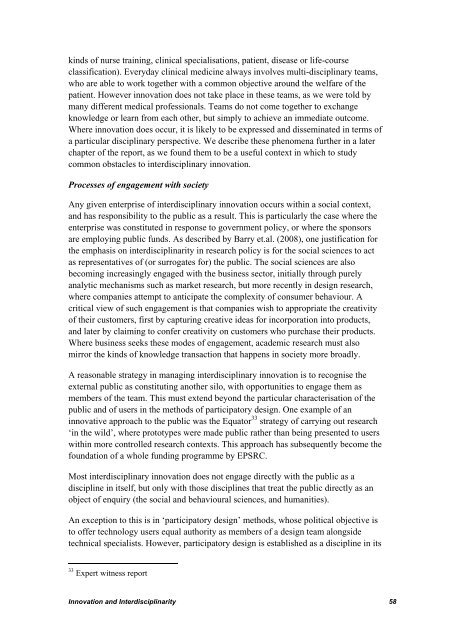Radical innovation: crossing knowledge boundaries with ...
Radical innovation: crossing knowledge boundaries with ...
Radical innovation: crossing knowledge boundaries with ...
Create successful ePaper yourself
Turn your PDF publications into a flip-book with our unique Google optimized e-Paper software.
kinds of nurse training, clinical specialisations, patient, disease or life-course<br />
classification). Everyday clinical medicine always involves multi-disciplinary teams,<br />
who are able to work together <strong>with</strong> a common objective around the welfare of the<br />
patient. However <strong>innovation</strong> does not take place in these teams, as we were told by<br />
many different medical professionals. Teams do not come together to exchange<br />
<strong>knowledge</strong> or learn from each other, but simply to achieve an immediate outcome.<br />
Where <strong>innovation</strong> does occur, it is likely to be expressed and disseminated in terms of<br />
a particular disciplinary perspective. We describe these phenomena further in a later<br />
chapter of the report, as we found them to be a useful context in which to study<br />
common obstacles to interdisciplinary <strong>innovation</strong>.<br />
Processes of engagement <strong>with</strong> society<br />
Any given enterprise of interdisciplinary <strong>innovation</strong> occurs <strong>with</strong>in a social context,<br />
and has responsibility to the public as a result. This is particularly the case where the<br />
enterprise was constituted in response to government policy, or where the sponsors<br />
are employing public funds. As described by Barry et.al. (2008), one justification for<br />
the emphasis on interdisciplinarity in research policy is for the social sciences to act<br />
as representatives of (or surrogates for) the public. The social sciences are also<br />
becoming increasingly engaged <strong>with</strong> the business sector, initially through purely<br />
analytic mechanisms such as market research, but more recently in design research,<br />
where companies attempt to anticipate the complexity of consumer behaviour. A<br />
critical view of such engagement is that companies wish to appropriate the creativity<br />
of their customers, first by capturing creative ideas for incorporation into products,<br />
and later by claiming to confer creativity on customers who purchase their products.<br />
Where business seeks these modes of engagement, academic research must also<br />
mirror the kinds of <strong>knowledge</strong> transaction that happens in society more broadly.<br />
A reasonable strategy in managing interdisciplinary <strong>innovation</strong> is to recognise the<br />
external public as constituting another silo, <strong>with</strong> opportunities to engage them as<br />
members of the team. This must extend beyond the particular characterisation of the<br />
public and of users in the methods of participatory design. One example of an<br />
innovative approach to the public was the Equator 33 strategy of carrying out research<br />
‘in the wild’, where prototypes were made public rather than being presented to users<br />
<strong>with</strong>in more controlled research contexts. This approach has subsequently become the<br />
foundation of a whole funding programme by EPSRC.<br />
Most interdisciplinary <strong>innovation</strong> does not engage directly <strong>with</strong> the public as a<br />
discipline in itself, but only <strong>with</strong> those disciplines that treat the public directly as an<br />
object of enquiry (the social and behavioural sciences, and humanities).<br />
An exception to this is in ‘participatory design’ methods, whose political objective is<br />
to offer technology users equal authority as members of a design team alongside<br />
technical specialists. However, participatory design is established as a discipline in its<br />
33 Expert witness report<br />
Innovation and Interdisciplinarity 58

















